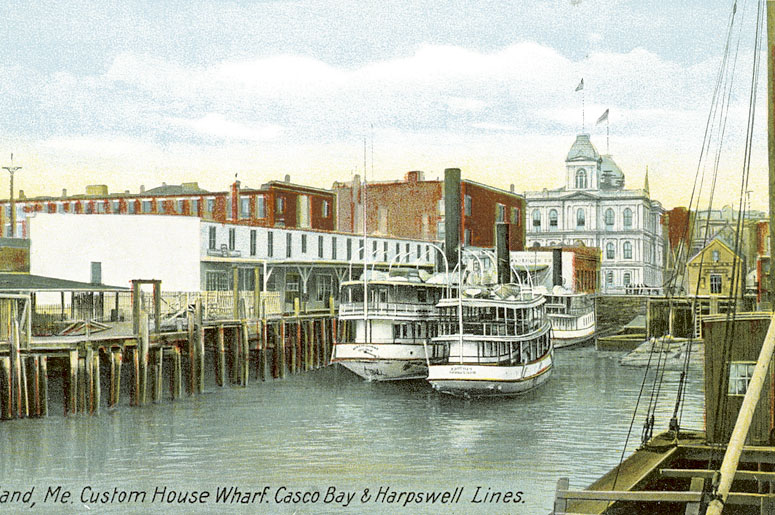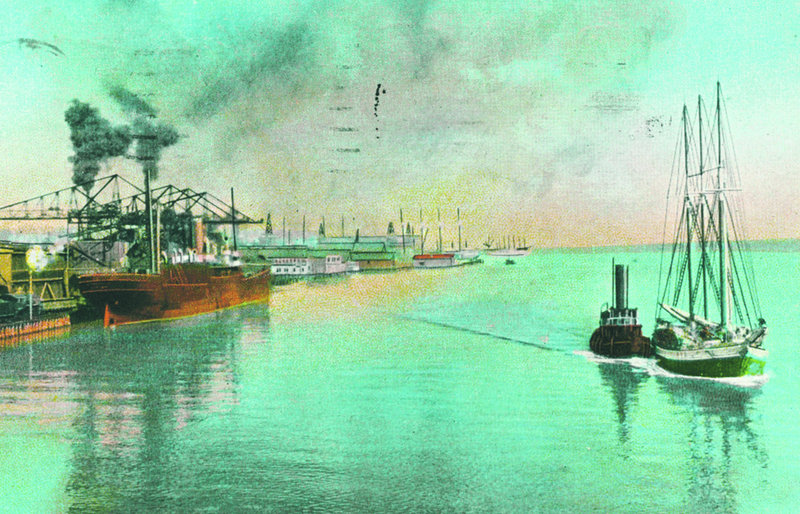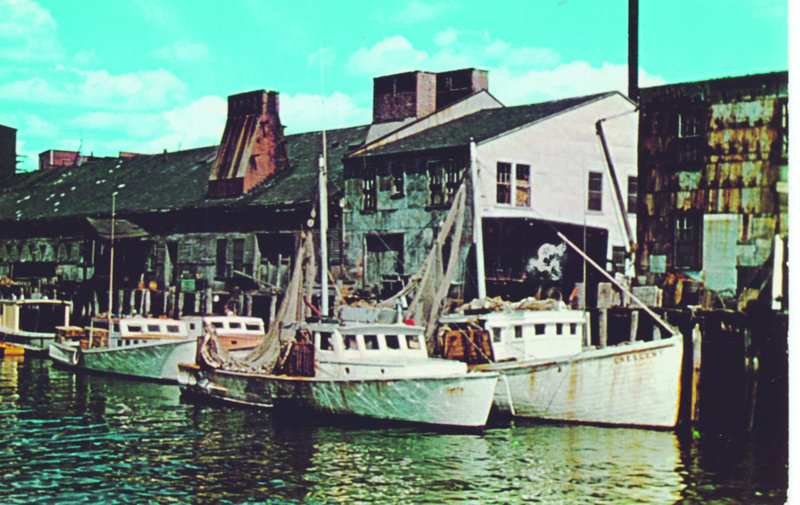Portland’s waterfront has long been viewed as contested urban space. In the 1830s and 1840s it boomed. Shipbuilding thrived, and thanks to entrepreneurs like John Bundy Brown, Portland boasted a brisk coastwise trade with the West Indies and Carolinas.
Longfellow memorialized this era in his poem “My Lost Youth” where he spoke not only of the “beautiful town seated by the sea,” but also of the “wharves and the slips, and Spanish sailors with bearded lips and the beauty and mysteries of the ships.”
By the Civil War the romance vanished. In the 1840s businessman John Poor unfurled his vision of Portland as a railroad hub with an economy built on handling cargoes of Canadian winter wheat shipped by rail from Montreal during those frigid months when the St. Lawrence froze. Portland paved over the old Fore Street wharves, creating the 100-foot-wide, 6,000-foot-long Commercial Street, and in order to build the locomotives and railcars for the new Atlantic and St. Lawrence Railroad (later Grand Trunk), Poor founded the Portland Company.
This kind of combat between visions for the Portland waterfront still drives debate, as fishing boats and processing operations battle for space with the creeping growth of offices, shops and restaurants. This may look like a modern conflict, but the city’s history shows it is nothing new. For more than a century Portland’s waterfront has been in a process of revision and rebirth that carries on through to today.
After the Civil War and the July 4, 1866, fire that consumed three-fourths of the city, Portland reveled in its role as a Canadian grain port and increasingly abjured industrialism, making Longfellow’s “city by the sea” more its brand than the poet’s wharves and slips. J.B. Brown abandoned sugar-making for real estate, and now hotels like the Falmouth and the Ottawa House made Portland the “Gateway to Vacationland.”
Portland embraced tourism, turning Deering Oaks into an idyllic pleasure ground and the banks of the once polluted Back Cove into parkland. But, the waterfront, once the heart of the city’s maritime economy, witnessed less and less commerce. Between 1880 and 1900 the size of Portland’s fleet decreased by half. The city’s great fear that its maritime economy was dying gained traction in 1923, when Canada shifted its wintertime grain commerce from Portland to Halifax and St. Johns, New Brunswick.
Although the needs of Maine’s paper industry for china clay and the laying of an oil pipeline between Portland and Montreal kept the port active in the 1920s, it languished again during the Great Depression. By World War II, Commercial Street and the Old Port looked haggard. Although the war revived shipbuilding and Portland hosted the North Atlantic destroyer fleet, the war-born revival faded after 1945.
The destruction in 1961 of the Union Station gave birth in 1964 to Greater Portland Landmarks, which in the 1970s worked along with Frank Akers of the Old Port Exchange to revive the city’s historic Old Port as a tourist attraction. Meanwhile, the waterfront languished. A 1969 report, “Port of Portland, Maine, Development Plan” urged transforming the pier complex into mixed residential, recreational and tourism uses. Two years later the Evening Express branded 36 percent of the waterfront buildings “dilapidated,” and 11 of the 34 piers “substandard.”
Mounting concern for the port’s sustainability led to a 1973 national City Edges grant that funded the 1975 waterfront plan, recommending “mixed” residential, retail, recreational and commercial uses, including a city-owned fish pier and a loading dock for container ships.
City Edges aside, many adamantly championed a strictly “working waterfront.” The two visions — a festive waterfront for hotels, housing, parks, museums, aquariums, etc., versus a “working waterfront” — clashed in the 1980s, especially after condominiums blanketed Chandlers Wharf. The debate ended in a March 1987 referendum where two to one, Portlanders approved an ordinance allowing only “marine-related” development on the waterfront.
In 1993, the City Council made the working waterfront law. Despite the 1993 law, Portland’s groundfishing industry steadily declined. In the 1990s the Fish Exchange handled 30 million pounds of fish; in 2010 just 6.4 million. Maritime-related businesses abandoned the waterfront. Owners like Charlie Poole complained that without tenants, owners could neither maintain nor pay taxes on their properties.
At the same time Portland emerged as a popular cruise ship destination. In 2007, near a site once occupied by the Grand Trunk grain elevators, Portland opened its $20.5 million, 21,000 square feet Ocean Gateway terminal. Unfortunately, once completed, the terminal proved too small for the giant Carnival Lines and almost on the same day Ottawa ended Canada’s subsidy for the Portland-to-Yarmouth, Nova Scotia, ferry. Portland failed in its 2009 bid to get $23 million in federal stimulus dollars to build a mega-berth adjoining the Ocean Gateway facility for the burgeoning cruise ship traffic.
In response to increasing calls for “flexibility,” the City Council in 2010 eased zoning on the piers and after $12 million in renovations, the law firm of Pierce Atwood moved its headquarters to Merrill’s Wharf, not far from Gorham’s Corner, a place unscathed by the 1866 fire and where West Indian molasses and rum had once been stored.
For good or bad, Portland’s waterfront remains contested, albeit familiar space. In appearance many of the wharves would seem easily recognizable to John Mead Gould. A Civil War veteran and teller at Exchange Street’s National Trader Bank, Gould frequently strolled the piers in the late 19th century. There is still the same bustle on Commercial Street today, without the clanking and rumble of shifting railcars, and the clatter of horse-drawn carriages on the cobblestones. There is still the smell of fish, and the same chatter of passengers disembarking from ships, albeit none hailing from Bremen, Liverpool or Southampton.
Send questions/comments to the editors.





Success. Please wait for the page to reload. If the page does not reload within 5 seconds, please refresh the page.
Enter your email and password to access comments.
Hi, to comment on stories you must . This profile is in addition to your subscription and website login.
Already have a commenting profile? .
Invalid username/password.
Please check your email to confirm and complete your registration.
Only subscribers are eligible to post comments. Please subscribe or login first for digital access. Here’s why.
Use the form below to reset your password. When you've submitted your account email, we will send an email with a reset code.